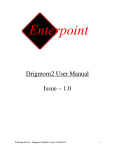Download XC6SLX150 X1 Coprocessor Module User Manual
Transcript
XC6SLX150 X1 Coprocessor Module User Manual Issue – 1.0 © Enterpoint Ltd. – XC6SLX150 X 1 Manual – Issue 1.0 7/9/2011 1 Foreword PLEASE READ THIS ENTIRE MANUAL BEFORE PLUGGING IN OR POWERING UP YOUR XC6SLX150 X1 Coprocessor MODULE. PLEASE TAKE SPECIAL NOTE OF THE WARNINGS WITHIN THIS MANUAL. Trademarks Spartan-6, ISE, Webpack, EDK, COREGEN, Xilinx are the registered trademarks of Xilinx Inc, San Jose, California, US. Contents Foreword Trademarks Introduction XC6SLX150 X1 Coprocessor Module FPGA SPI FLASH DDR3 MEMORY DIL HEADERS OSCILLATOR POWER CONNECTIONS BATTERY POWER REGULATORS PROGRAMMING XC6SLX150 X1 Coprocessor Module MECHANICAL Medical and Safety Critical Use © Enterpoint Ltd. – XC6SLX150 X 1 Manual – Issue 1.0 7/9/2011 2 2 3 4 5 7 8 11 13 14 14 15 16 19 20 2 Warranty Support © Enterpoint Ltd. – XC6SLX150 X 1 Manual – Issue 1.0 7/9/2011 20 20 3 Introduction The Enterpoint XC6SLX150 X1 Coprocessor Module is a Spartan-6 FPGA based module offering a highly powerful, flexible and low cost approach to extending the performance and processing power of our range of development boards. It can be plugged into our Raggedstone1, Raggedstone2, Drigmorn 3 or 4 or Broaddown series boards. It can also be used as a stand-alone module using its 0.1inch pitch header pins to interface to a user’s power and JTAG circuit. Enterpoint’s Raggedstone2 development board with 2 XC6SLX150 X1 Coprocessor Modules The aim of this manual is to assist in using the main features of the XC6SLX150 X1 Coprocessor Module. There are features that are beyond the scope of the manual. Should you need to use these features then please email [email protected] for detailed instructions. The XC6SLX150 X1 Coprocessor Module currently comes with an XC6SLX1502FGG484C Spartan-6. Other variants may be offered at a later date or as an OEM product. Please contact out us on [email protected] should you need further information. We can offer a PCB design service to interface with this product should you require a function not covered by our current range of development boards. Typical turn around for this service is 6-8 weeks depending upon complexity, quantity ordered and availability of components. © Enterpoint Ltd. – XC6SLX150 X 1 Manual – Issue 1.0 7/9/2011 4 XC6SLX150 X1 Coprocessor Module XC6SLX150 X1 Coprocessor Module Front View XC6SLX150 X1 Coprocessor Module Back View © Enterpoint Ltd. – XC6SLX150 X 1 Manual – Issue 1.0 7/9/2011 5 The XC6SLX150 X1 Coprocessor Module will be supplied un-programmed. You will need a programming cable to program the XC6SLX150 X1 Coprocessor Module – for example the Enterpoint Prog2 parallel port programming cable or the Enterpoint Prog3 USB port programming cable. The Xilinx toolset required to program the XC6SLX150 X1 Coprocessor Module depends upon the Spartan6 device fitted to the board. If your XC6SLX150 X1 Coprocessor Module is fitted with an LX150 device (standard version) it will require the full Xilinx toolset to build a design. If you have a custom version fitted with an LX75 device or smaller it is supported by the free ISE Webpack . ISE Version11.1 SP4 or later is required, available from Xilinx. This provides all the tools to enter and build a design. Using this tool in conjunction with your programming cable you will also be able to program the Spartan-6, and the supporting SPI Flash, that are on the XC6SLX150 X1 Coprocessor Module. ISE Webpack can be obtained directly from the Xilinx website at http://www.xilinx.com/ise. Registration will be necessary to complete the download. The full ISE toolset can also be purchased from the Xilinx website. © Enterpoint Ltd. – XC6SLX150 X 1 Manual – Issue 1.0 7/9/2011 6 FPGA The XC6SLX150 X1 Coprocessor Module supports Spartan-6 devices in the FGG484 package. This module is normally available with commercial grade -2 speed devices fitted in the XC6SLX150 size. Should you have an application that needs a different size of FPGA, industrial specification parts or faster speed grades please contact sales for a quote at [email protected]. The FPGA PROG_B signal is routed to the Right Side DIL header and is available on pin 10 (outer row) should the user wish to initiate reconfiguration of the Spartan6. © Enterpoint Ltd. – XC6SLX150 X 1 Manual – Issue 1.0 7/9/2011 7 SPI FLASH MEMORY SPI FLASH MEMORY The M25P128 SPI flash memory device configures the FPGA when it is powered provided a suitable bitstream is programmed into the device. The M25P128 has a capacity of 128Mbits with a single configuration bitstream for the XC6SLX150 X1 Coprocessor Module taking 4.1Mbits. Any remaining space can be used for alternative configurations or code and data storage. The SPI flash memory signals are routed to the Right side outer DIL header on the pins shown in the table below. After configuration the SPI Flash can be accessed via the following pins of the FPGA: M25P128 FUNCTION CCLK MOSI WRITE DIN CSO_B HOLD FPGA PIN Y21 AB20 U9 AA20 T5 U13 RIGHT HEADER PIN 8 9 11 10 12 7 The flash memory can be programmed via the JTAG interface. © Enterpoint Ltd. – XC6SLX150 X 1 Manual – Issue 1.0 7/9/2011 8 DDR3 MEMORY XC6SLX150 X1 Coprocessor DDR3 The XC6SLX150 X1 Coprocessor Module has two 1GBIT DDR3 Micron MT41J64M16LA devices as standard. These devices are organised as 8 Meg x 16 x 8 banks and are supported by the hard core memory controller that is in the Spartan-6 FPGA. To add this core to your design the COREGEN tool, part of the ISE suite, will generate implementation templates in VHDL or Verilog for the configuration that you want to use. More details on the memory controller can be found in the user guide http://www.xilinx.com/support/documentation/user_guides/ug388.pdf. The DDR3 has 12 address lines and 16 data lines to address all the available memory, which can be accessed at speeds of 1.87ns. More details of the DDR3 can be found in http://download.micron.com/pdf/datasheets/dram/ddr3/1Gb_DDR3_SDRAM.pdf. For OEM applications we can fit bigger DDR3 parts subject to limitations of the memory controller. © Enterpoint Ltd. – XC6SLX150 X 1 Manual – Issue 1.0 7/9/2011 9 The upper DDR3 device has the following connections to the FPGA: DDR3 FUNCTION DDR_A0 DDR_A1 DDR_A2 DDR_A3 DDR_A4 DDR_A5 DDR_A6 DDR_A7 DDR_A8 DDR_A9 DDR_A10 DDR_A11 DDR_A12 DDR_A13 DDR_A14 DDR_A15 DDR_BA0 DDR_BA1 DDR_BA2 DDR_CS_N DDR_RAS_N DDR_WE_N DDR_DQ0 DDR_DQ1 DDR_DQ2 FPGA PIN F21 F22 E22 G20 F20 K20 K19 E20 C20 C22 G19 F19 D22 D19 D20 B21 J17 K17 H18 P20 H2 H19 N20 N22 M21 DDR3 FUNCTION DDR_DQ3 DDR_DQ4 DDR_DQ5 DDR_DQ6 DDR_DQ7 DDR_DQ8 DDR_DQ9 DDR_DQ10 DDR_DQ11 DDR_DQ12 DDR_DQ13 DDR_DQ14 DDR_DQ15 DDR_LDM DDR_LDQS DDR_LDQS_N DDR_UDM DDR_UDQS DDR_UDQS_N DDR_ODT DDR_CAS_N DDR_RESET_N DDR_CKE DDR_CLK_N DDR_CLK FPGA PIN M22 J20 J22 K21 K22 P21 P22 R20 R22 U20 U22 V21 V22 L19 L20 L22 M20 T21 T22 G22 H22 F18 D21 J19 H20 The lower DDR3 device has the following connections to the FPGA: DDR3 FUNCTION DDR_A0 DDR_A1 DDR_A2 DDR_A3 DDR_A4 DDR_A5 DDR_A6 DDR_A7 DDR_A8 DDR_A9 FPGA PIN H2 H1 H5 K6 F3 K3 J4 H6 E3 E1 DDR3 FUNCTION DDR_DQ3 DDR_DQ4 DDR_DQ5 DDR_DQ6 DDR_DQ7 DDR_DQ8 DDR_DQ9 DDR_DQ10 DDR_DQ11 DDR_DQ12 © Enterpoint Ltd. – XC6SLX150 X 1 Manual – Issue 1.0 7/9/2011 FPGA PIN M1 J3 J1 K2 K1 P2 P1 R3 R1 U3 10 DDR_A10 DDR_A11 DDR_A12 DDR_A13 DDR_A14 DDR_A15 DDR_BA0 DDR_BA1 DDR_BA2 DDR_CS_N DDR_RAS_N DDR_WE_N DDR_DQ0 DDR_DQ1 DDR_DQ2 G4 C1 D1 G6 F5 H8 G3 G1 F1 J7 K5 F2 N3 N1 M2 DDR_DQ13 DDR_DQ14 DDR_DQ15 DDR_LDM DDR_LDQS_P DDR_LDQS_N DDR_UDM DDR_UDQS_P DDR_UDQS_N DDR_ODT DDR_CAS_N DDR_RESET_N DDR_CKE DDR_CLK_N DDR_CLK_P U1 V2 V1 L4 L3 L1 M3 T2 T1 J6 K4 C3 D2 H3 H4 The signals shown shaded in yellow are terminated using suitable arrangements of resistors. © Enterpoint Ltd. – XC6SLX150 X 1 Manual – Issue 1.0 7/9/2011 11 DIL HEADERS The DIL Headers provide a simple mechanical and electrical interface for connection to the module. There are twenty I/O on the left side of the module and up to 12 IO on the right hand side of the module giving a total of 32 possible I/O available. 4 of the IO on the right hand side of the module (Right Header outer pins 1 to 4) are shared with the JTAG signals and pass through bus switches. Bus switch technology has a minimal effect on I/O timing with propagation times of less than 250ps through these devices. The DIL Headers can support up 16 pairs of LVDS signalling. The Spartan-6 FPGA can terminate any of these pairs. LVDS termination on individual signal pairs is a programmable option that can be set in build constraints for the FPGA when using the ISE toolset. The LVDS pairs are shown in the table above along with Spartan-6 pin numbers. The DIL Headers will also support the use of crude prototype circuits using stripboard or other prototype materials. The DIL Header connectors are arranged on a standard 0.1inch (2.54mm) pitch. The horizontal pitch of the DIL Headers is 1.6 inches between the outer rows of the headers. The inner pins of the header form continuous power strips. The right hand side header has an inner column of 3.3V pins. The LHS header has an inner column of DGND (0V). © Enterpoint Ltd. – XC6SLX150 X 1 Manual – Issue 1.0 7/9/2011 12 ROW 1 2 3 4 5 6 7 8 9 10 11 12 13 14 15 16 17 18 19 20 LEFT COLUMNS OUTER PINS INNER PINS FUNCTION S6 PIN IO_L63P_0 B16 0V IO_L63N_0 A16 0V IO_L51P_0 C15 0V IO_L51N_0 A15 0V IO_L38P_0 C13 0V IO_L38N_0 A13 0V IO_L37P_0 B12 0V IO_L37N_0 A12 0V IO_L35P_0 C11 0V IO_L35N_0 A11 0V IO_L34P_0 B10 0V IO_L34N_0 A10 0V IO_L8P_0 C9 0V IO_L8N_0 A9 0V IO_L6P_0 B8 0V IO_L6N_0 A8 0V IO_L4P_0 B6 0V IO_L4N_0 A6 0V IO_L2P_0 C5 0V IO_L2N_0 A5 0V INNER PINS 3.3V 3.3V 3.3V 3.3V 3.3V 3.3V 3.3V 3.3V 3.3V 3.3V 3.3V 3.3V 3.3V 3.3V 3.3V 3.3V 3.3V 3.3V 3.3V 3.3V RIGHT COLUMNS OUTER PINS FUNCTION S6 PIN IO_L2P_2/TMS AA21 IO_L2N_2/TDO AB21 IO_L5P_2/TDI Y19 IO_L5N_2/TCK AB19 IO_L14P_2 AA18 IO_L14N_2 AB18 HOLD U13 CCLK Y21 MOSI AB20 DIN AA20 WRITE U14 CSO_B T5 PROG_B AA1 JTAG_ENABLE IO_L49P_2 AB6 IO_L49N_2 AA6 IO_L57P_2 AA4 IO_L57N_2 AB4 IO_L64P_2 AA2 IO_L64N_2 AB2 It should be noted that the pins on the XC6SLX150 X1 Coprocessor Module should be treated with respect. The XC6SLX150 X1 Coprocessor Module is usually supplied with an extra row of pin-socket headers to protect the row of pins which are soldered into the board. This means that if a pin is broken this extra row of headers can be replaced easily and cheaply. Enterpoint can supply extra pins-socket headers if required. Contact [email protected]. Enterpoint does not accept responsibility if the header pins on the module have been damaged due to poor handling. © Enterpoint Ltd. – XC6SLX150 X 1 Manual – Issue 1.0 7/9/2011 13 OSCILLATOR The oscillator on the XC6SLX150 X1 Coprocessor Module is an ASEM 25MHz oscillator. The oscillator is situated as shown below and is connected to the FPGA on PIN AB13. The Spartan-6 has PLLs and DCMs to produce multiples, divisions and phases of the clock for specific application requirements. Please consult the Spartan-6 datasheet available from the Xilinx website at http://www.xilinx.com if multiple clock signals are required. © Enterpoint Ltd. – XC6SLX150 X 1 Manual – Issue 1.0 7/9/2011 14 POWER CONNECTIONS The user must supply 3.3v to the module on any or all of the right hand side inner header pins and 0V on any or all of the left hand side inner header pins. This can be achieved by plugging the module into one of the Enterpoint Raggedstone, Drigmorn or Broaddown series development boards, which all have sockets with appropriate power connections for this module and resettable fuses to limit the current. Alternatively the user may wish to plug the module into his/her own circuitry. Whatever power supply is used care should be taken not to exceed 3.3v input as this can cause damage to the XC6SLX150 X1 Coprocessor Module. BATTERY A battery holder is supplied on the underside of the XC6SLX150 X1 Coprocessor Module that can take a nominal 4.8mm diameter, 1.5mm thick rechargeable coin cell battery providing 1V to 3.6V e.g Panasonic ML414S/ZT. We do not normally supply the battery to avoid shipping issues with batteries. It is connected to pin R17 of the FPGA and recharges from the 3.3V supply. VBATT is required to maintain the battery backed RAM AES key when VCCAUX is not applied to the FPGA. © Enterpoint Ltd. – XC6SLX150 X 1 Manual – Issue 1.0 7/9/2011 15 POWER REGULATORS The XC6SLX150 X1 Coprocessor Module has three regulators supplying 1.5V, 1.2V and 0.75V power rails. WARNING – REGULATORS CAN BECOME HOT IN NORMAL OPERATION ALONG WITH THE BOARDS THERMAL RELIEF. PLEASE DO NOT TOUCH OR PLACE HIGHLY FLAMABLE MATERIALS NEAR THESE DEVICES WHILST THE XC6SLX150 X1 COPROCESSOR MODULE IS IN OPERATION. A Micrel MIC22600 regulator supplies 1.2V with a maximum current available of 6A. This is used for the core voltage of the FPGA . A Diodes Inc. AP7167 linear regulator supplies 1.5V with a maximum current of 1.2A for the DDR3. A National Semiconductor LP2996 push-pull regulator produces up to 1.5A at 0.75V. This supply is used as reference and termination voltage for the DDR3 memory and related FPGA I/O. © Enterpoint Ltd. – XC6SLX150 X 1 Manual – Issue 1.0 7/9/2011 16 Programming XC6SLX150 X1 Coprocessor Module The programming of the FPGA and SPI Flash parts on the XC6SLX150 X1 Coprocessor Module is achieved using the JTAG interface. There is no JTAG connector on the XC6SLX150 X1 Coprocessor Module. The JTAG signals are routed to the following pins on the Right side DIL header (outer column). These signals should be routed through a host board to a JTAG connector if you wish to program the Coprocessor module directly. JTAG SIGNAL HEADER PIN TDI 3 2 4 1 14 TDO TCK TMS JTAG ENABLE These pins are also routed to GPIO on the Spartan-6 FPGA which can be used after the FPGA programming is complete. When the JTAG ENABLE signal is LOW the header pins are routed to the GPIO as shown previously in the section DIL HEADERS. When the JTAG ENABLE signal is asserted HIGH the JTAG signals are connected to the Header pins and those GPIO are not available. Principally it is anticipated that a JTAG connection will be used in conjunction with Xilinx ISE software although other alternatives do exist including self reprogramming. The Spartan-6 series needs to be programmed using ISE 11 or higher. Versions of ISE prior to 11 do not support Spartan-6. The full version of the Xilinx tools is required to program the XC6SLX150-2FGG484C. The free Webpack version of ISE is sufficient to support the smaller versions of the FPGA. There is a single JTAG chain on the XC6SLX150 X1 Coprocessor Module. The JTAG chain allows the programming of the Spartan-6 and SPI Flash device. Using iMPACT Boundary Scan the JTAG chain appears like this: © Enterpoint Ltd. – XC6SLX150 X 1 Manual – Issue 1.0 7/9/2011 17 1. Programming the FPGA directly. Direct JTAG programming of the Spartan-6 FPGA is volatile and the FPGA will lose its configuration every time the board power is cycled. For sustained use of an FPGA design programming the design into the Flash memory is recommended (see 2 and 3 below). Direct JTAG programming using .bit files is useful for fast, temporary programming during development of FPGA programs. Right click the icon representing the Spartan-6 FPGA and choose ‘Assign New Configuration File’. Navigate to your .bit file and choose ‘OPEN’. The next dialogue box will offer to add a flash memory and you should decline. Right click the icon representing the Spartan-6 FPGA and choose ‘Program’. On the next dialogue box ensure that the ‘Verify’ box is not checked. (If it is you should uncheck it, failure to do this will result in error messages being displayed). Click OK. The Spartan-6 will program. This process is very quick (typically a few seconds) 2. Programming the SPI flash memory using Boundary Scan. Once the SPI Flash memory has been programmed, the Spartan-6 device will automatically load from the Flash memory at power up. Generation of suitable Flash memory files (.mcs) can be achieved using ISE iMPACT’s Prom File Formatter. Right click on the icon representing the Spartan-6 and choose ‘Add SPI/BPI Flash’ Navigate to your programming file (.mcs) and click OPEN. Use the next dialogue box to select SPI flash and M25P128 . Data width should be set to 1. The flash memory should appear as shown below. Right click on the icon representing the flash memory and choose ‘Program’ to load your program into the device. It is recommended that options to ‘Verify’ and ‘Erase © Enterpoint Ltd. – XC6SLX150 X 1 Manual – Issue 1.0 7/9/2011 18 before programming’ are chosen. Otherwise all defaults can be accepted. The programming operation will take some time (at least 3 or 4 minutes). Depending upon the settings used when generating the bitfile using ISE, it will take up to 20 seconds for the XC6LX150 to configure upon power-up. In order to decrease this time the following process can be followed: 1. In the main ISE menu, right-click ‘Generate Programming file’. Choose Properties. 2. On the left hand side of the Process Properties Dialogue box, choose Configuration Options. 3. The first item on the menu which appears on the right hand side of the dialogue box is ‘Configuration Rate’. The default setting is 2. Increase this number. The maximum value we suggest is 22. Choose ‘Apply’ and ‘OK’. 4. Generate the program file as normal. © Enterpoint Ltd. – XC6SLX150 X 1 Manual – Issue 1.0 7/9/2011 19 MECHANICAL ARRANGEMENT The Dimensions on the drawings below are millimetres (mm). All sizes quoted are subject to manufacturing tolerances and should only be used as a general guide. The socket pins on the DIL headers are arranged on a 2.45mm (0.1inch) pitch The maximum height of the components, measured from the lower surface of the board is 5mm. When the XC6SLX150 X1 Coprocessor Module is plugged into a Raggedstone2 development board using doubled header pins the total height from the underside of the Raggedstone2 to the top of the XC6SLX150 X1 Coprocessor Module components is approximately 22mm. © Enterpoint Ltd. – XC6SLX150 X 1 Manual – Issue 1.0 7/9/2011 20 Medical and Safety Critical Use XC6SLX150 X1 Coprocessor Modules are not authorised for the use in, or use in the design of, medical or other safety critical systems without the express written person of the Board of Enterpoint. If such use is allowed the said use will be entirely the responsibility of the user. Enterpoint Ltd accepts no liability for any failure or defect of the XC6SLX150 X1 Coprocessor Module, or its design, when it is used in any medical or safety critical application. Warranty The XC6SLX150 X1 Coprocessor Module comes with a 90 day return to base warranty. Do not attempt to solder connections to the XC6SLX150 X1 Coprocessor Module. Enterpoint reserves the right not honour a warranty if the failure is due to soldering or other maltreatment of the XC6SLX150 X1 Coprocessor Module. Outside warranty Enterpoint offers a fixed price repair or replacement service. We reserve the right not to offer this service where a XC6SLX150 X1 Coprocessor Module has been maltreated or otherwise deliberately damaged. Please contact support if you need to use this service. Other specialised warranty programs can be offered to users of multiple Enterpoint products. Please contact sales on [email protected] if you are interested in these types of warranty, Support Please check our online FAQ page for this product first before contacting support. Telephone and email support is offered during normal United Kingdom working hours (GMT or GMT + 1) 9.00am to 5.00pm. Telephone - +44 (0) 121 288 3945 Email - [email protected] © Enterpoint Ltd. – XC6SLX150 X 1 Manual – Issue 1.0 7/9/2011 21





















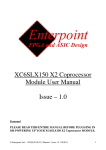


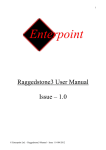
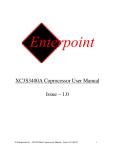
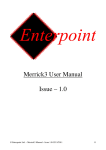





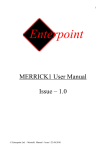


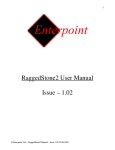
![Atari ST System-on-Chip in VHDL (Author: Lyndon Amsdon) [undated]](http://vs1.manualzilla.com/store/data/005994841_1-cb1a0817df59f22c671df08194997a7c-150x150.png)

